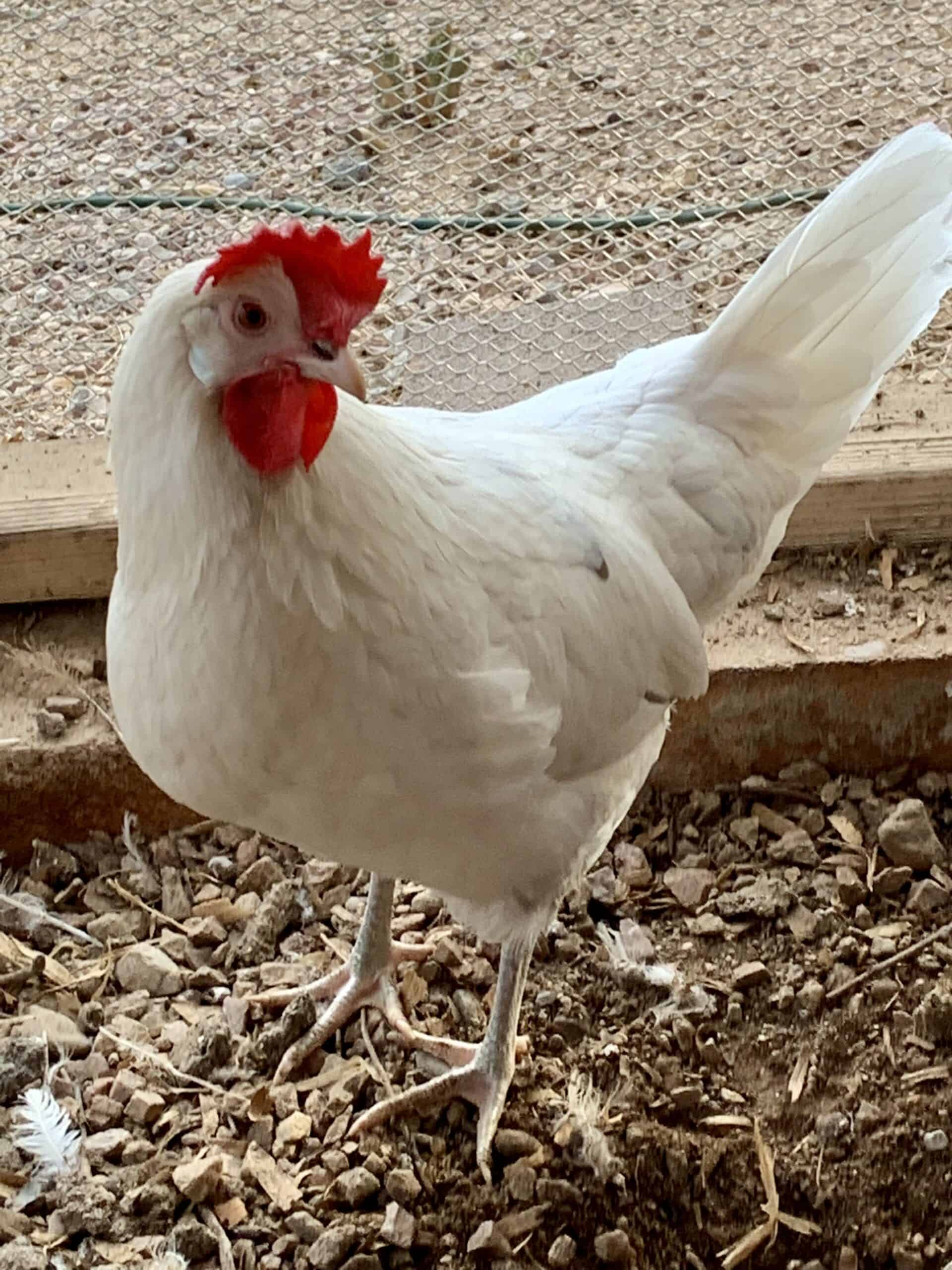The California White chicken, robust and resilient, is an ideal choice for first-time chicken owners who want lots of eggs. Ideal for backyards and practical for those residing in urban settings, these friendly, prolific layers are sure to win your heart.
California Whites are a fitting choice if you are looking for a small or medium flock. I say this because with just a few hens, you can enjoy an abundance of eggs. With four productive hens, averaging over the course of the year, you could enjoy almost two dozen eggs each week. (They lay less often in the colder months.)
These white chickens are crossbred from the California Gray rooster and the White Leghorn hen. The result is a striking hybrid lauded for its rapid growth and productivity, particularly when it comes to egg-laying.
California Whites hens are capable of producing around 300 large white eggs annually.
Their utility extends beyond only egg production. They are dual-purpose and excellent meat providers. This means you can cull older unproductive hens if you wish. In addition, if you raise a rooster and hatch chicks, you can use the males for meat.
Two of the California White chicken’s standout traits are its egg production (from their Leghorn ancestry) and calm demeanor (from their California Gray lineage). Unlike their more vocal Leghorn relatives, California Whites prefer the quiet life.
This quality makes them a perfect choice for suburban coops where noise could be a concern.
Friendly and hardy, they have a natural flair for adapting to close confinement and thrive in backyards and farm settings alike. Due to their efficient growth rate, they’re known to start laying as early as four months old, outshining their White Leghorn counterparts.
All of these attributes contribute to the California White chicken’s egg-cellent reputation. With a flock of these feathered friends, you’ll be well on your way to enjoying the wholesome pleasures of backyard poultry.
Keep reading and get to know the California White chicken and how it might be a great choice for your backyard. Because it’s also cold hardy and heat tolerant, with proper shelter and care, you can raise it in most climates.
California White Chicken
While many chicken breeds stop laying in the colder months when there is less light, the California White chicken’s egg production will slow down but will not stop. So expect less eggs as the days get shorter. Hens can begin laying as soon as they are four months young.
Their health, hardiness, resiliency, and grit are also noteworthy. As a hybrid, they get the best of both breeds: The genetic excellence of the California Grey rooster and the White Leghorn hen. The result is the California White chicken with a superior hybrid vigor.
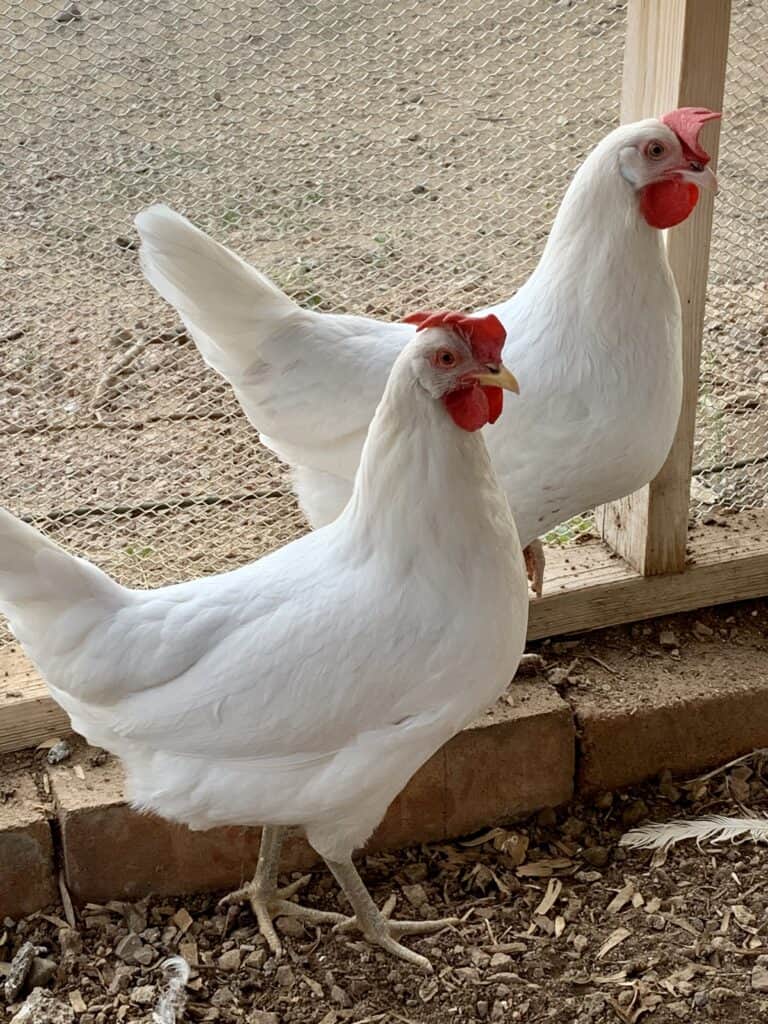
Dual-Purpose Advantage
When it comes to chickens, some breeds excel in egg production, while others are known for their quality meat. This is a hybrid that offers a superior combination of both. They are abundant egg-layers and a reliable source of quality meat.
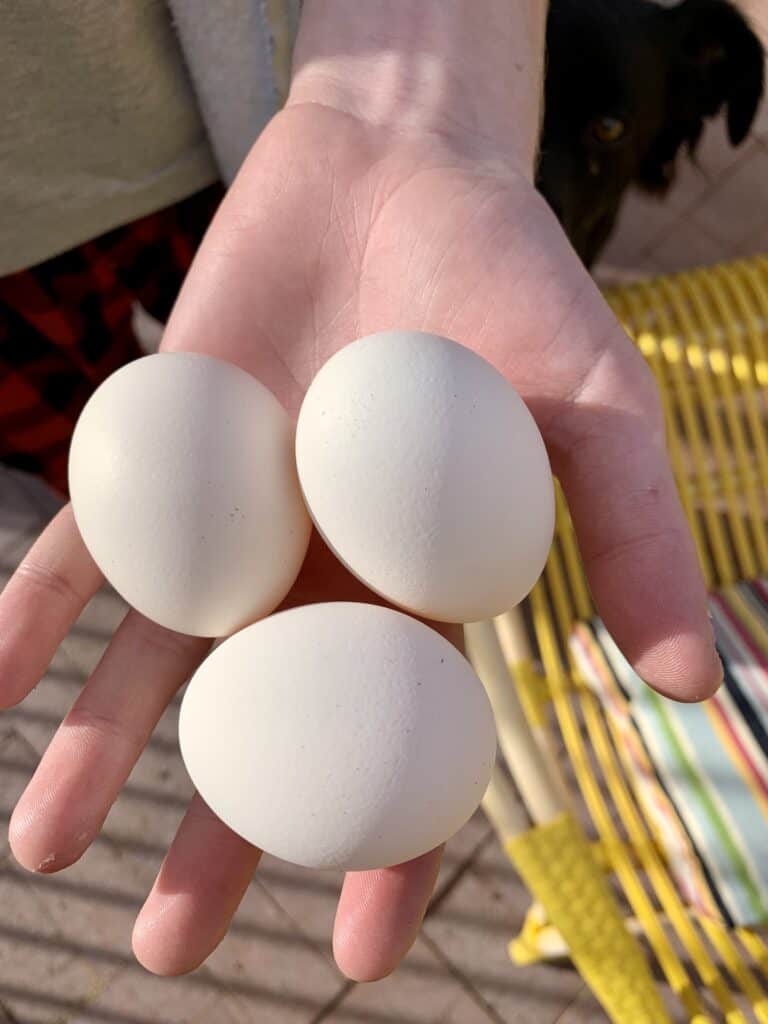
California White Chicken Egg Production
California White pullets are known for their swift maturity, beginning egg-laying journey as early as 17 weeks old. As a hybrid, their annual egg yield generally surpasses that of purebred counterparts. California White hens lay large white eggs and outperform their White Leghorn mothers in annual egg production.
Upon reaching full maturity, these hens display an exceptional laying capacity amounting to an impressive average of 300 eggs annually. Their productivity extends for around three years, with some hens producing longer.
Meat Production
The dual-purpose attribute of the California White chicken adds to their appeal. Alongside being productive egg-layers, they can also be considered for meat as they age and their laying productivity decreases. As I said above, you may decide to use the males for meat as well.
Capitalizing on California White Chickens for Meat
Their mature weight and overall robust health yield a substantial quantity of good-quality meat. This dual-purpose characteristic makes them a wise choice for chicken enthusiasts who value both egg and meat production.
California White Roosters
If you are considering raising a California White rooster among your hens, they are generally less aggressive compared to other roosters, showcasing a more docile nature. This being said, like any rooster, they are protective of their flock and will defend their hens if they perceive a threat.
If you consider the pros and cons of keeping a rooster and decide it’s right for you, know that it will crow and work hard to protect its flock. Although they are less loud than some breeds, they will still crow, announcing the dawn and asserting their presence. In terms of flock dynamics, they maintain order, ensuring the hens are safe.
You do NOT need a rooster for your hens to lay eggs. However, you do need a rooster with your hens if you want to have fertile eggs you can hatch. (Keep in mind California White hens are not typically broody.) The roosters are hardy, displaying similar adaptability to varying conditions as the hens of the breed.
If you are keeping a rooster for the purpose of meat production, the California White rooster has a good growth rate and produces a respectable amount of meat. However, the primary utility of keeping a rooster of this breed is typically for fertilization of eggs, not for meat production.
Raised alongside the hens, hatcheries often choose to raise the roosters to fertilize eggs before sending them off as a source of meat. California White roosters grow to around 7 pounds, making them ideal for the dinner table.
If you’re considering adding a rooster to your flock, the California White rooster is a commendable choice. With their combination of pleasing aesthetics, generally calm demeanor compared to more aggressive roosters, and protective nature, they make a valuable addition to any backyard or farm flock.
If you keep a rooster among your hens, you should have 8 – 10 hens to reduce stress on them.
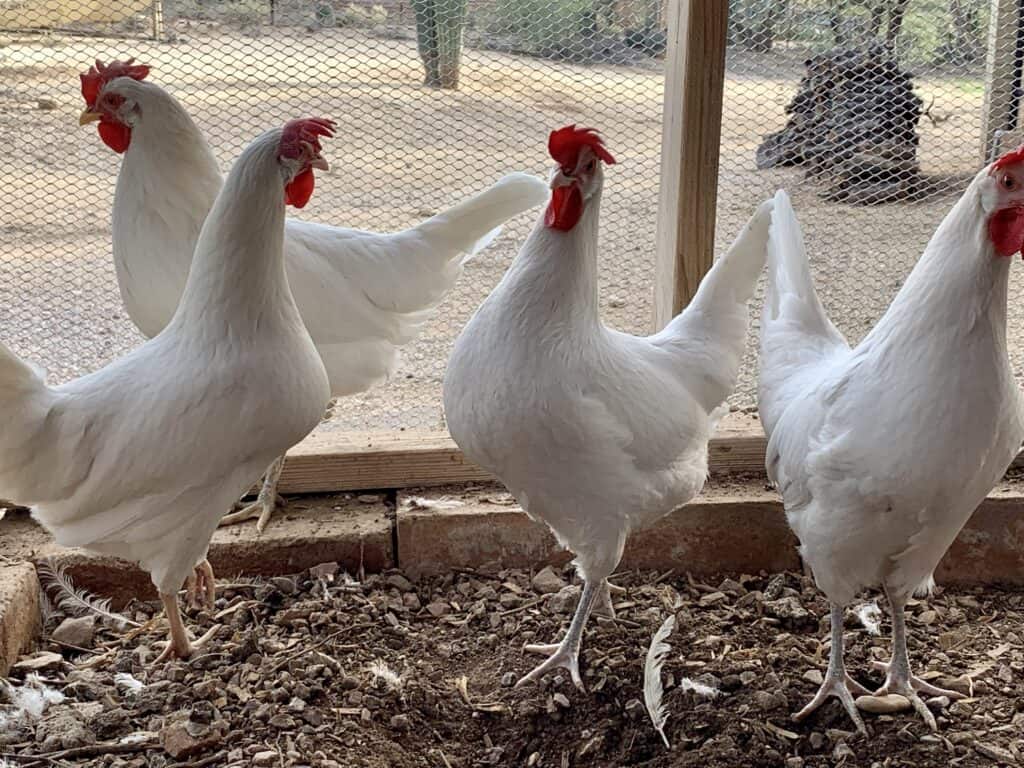
Broodiness
The California White chicken seldom goes broody. This means they usually don’t develop the urge to sit on and hatch eggs, ensuring they remain consistently productive layers without the pauses that brooding periods can cause.
Personality and Temperament
For those who prefer quiet, amicable companions in their backyard, these birds provide a perfect match. They have a low-key temperament, friendly nature, and are comfortable with handling. I wouldn’t consider them lap chickens but they make good pets.
My flock of California White chickens certainly keeps things interesting with their diverse range of personalities. My flock is sociable and friendly, welcoming a gentle stroke but I did raise them as chicks and handled them often when they were young.
One of the many perks of raising California Whites is their non-territorial nature, allowing for peaceful coexistence with other hens. But it’s always crucial to give them enough space; over-crowding can lead to stress.
Remarkably adaptable, my California Whites are troopers when it comes to weather changes. When it gets colder out, they still have the chance to free range and get sunlight which helps with their egg production.
While they’re great for laying a bounty of eggs, they’re also fun pets to keep. From my perspective, they’re a top choice for those just starting their journey into poultry raising.
It’s true California Whites may not be overtly sociable, I’ve found them to be interactive, enjoying both human company and the companionship each other. They love treats and having the opportunities to scratch and free range when it’s safe to do so. They are adaptable, resilient, and curious.
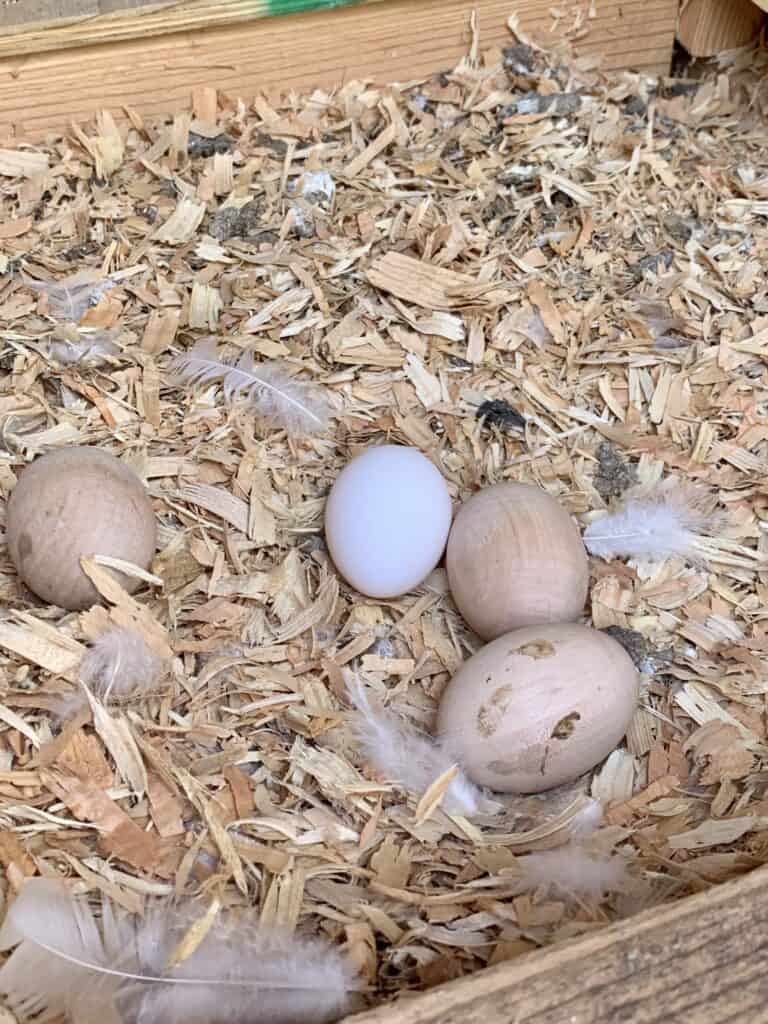
Contrary to their White Leghorn ancestry, California Whites exhibit a calmer demeanor, showing less flightiness even in the hen house or during egg collection. They love a good free-range run, but their bright white feathers can make them an easy target for hawks, owls, coyotes, and owls. Having a chicken run with chicken wire on top is helpful.
Their gentle and composed personality, paired with their large, regular egg production, makes them a highly recommended breed for families with kids.
The California White is a charming mix of the best attributes of their parent breeds, combining the White Leghorn’s prolific egg laying without the noise, and the sociable disposition and stature of the California Gray. Gentle, curious, and intelligent, they are very rarely aggressive and get along well with people and each other.
Their adaptable and friendly nature makes them a suitable breed for beginners, providing a balance of engaging interaction and a generous supply of eggs.
Raising them in the backyard or as part of a mixed flock with other mild-mannered chickens is a breeze. One thing to note, though, is that California Whites can take to the air higher than most average chickens, so it’s essential to have adequate containment when letting them free-range.
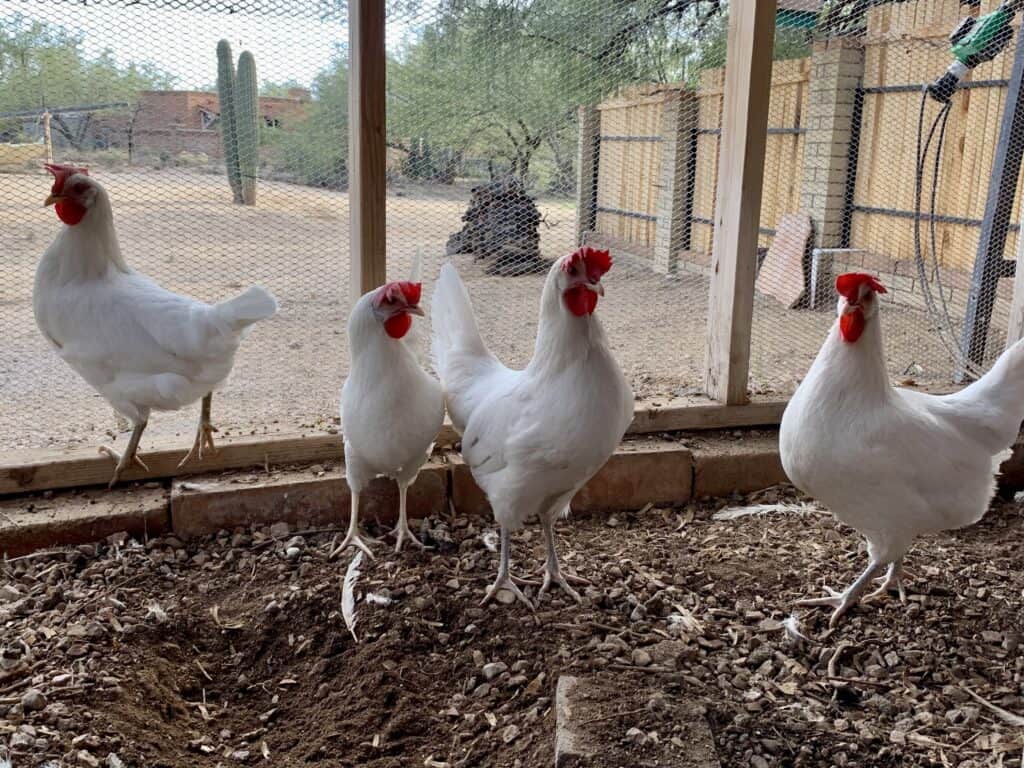
Hardiness
The robust California White thrives in cool and hot environments and maintains a steady egg production, even in the fall when other breeds may reduce output. They handle confinement well and adapt to a range of living conditions with ease.
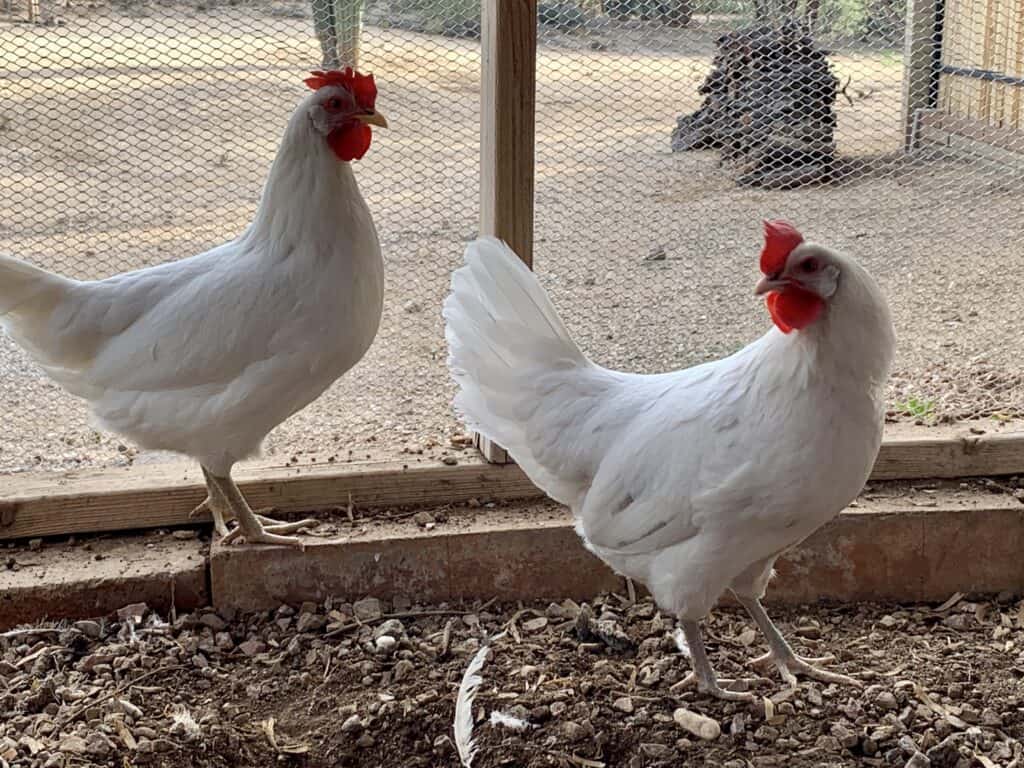
Appearance
As an owner of a flock of California White chickens, I can say firsthand that they are indeed charming birds. With an appearance similar to White Leghorns, distinguishing between the two can prove to be a bit of a challenge.
Despite the lack of a recognized breed standard for the California Whites, they carry an upright, appealing Mediterranean style.
As chicks, these birds display a light yellow plumage with black flecks, which develops into a predominantly white coat as they mature, occasionally interspersed with black specks.
They have clean legs and feet.
Unmistakable characteristics of both the hens and roosters include their radiant white feathers, red wattles, combs, and earlobes. You may also find small black spots on their lower backs or tail feathers.
They boast long primary flight feathers which, though they can’t take them sky-high, do allow for short-distance flights. I’ve often been amused at where my California Whites end up in the yard. But rest assured, they’re not escape artists; a tall perimeter fence will keep your flock safely contained.
These birds are not just beautiful but also versatile. They adapt well to their environment and thrive in both confined and free-ranging settings. California Whites weigh an average of 5.5 pounds for hens and 7 pounds for roosters, slightly larger than their Leghorn counterparts.
They also have larger combs than their parent breeds and tend to stand more upright.
One thing I admire about my California Whites is their hardiness through all seasons. They continue their energetic egg production into the autumn months when most other chicken breeds slow down. There is not a California White Bantam version but the “full-size version” of this breed is manageable.
Lifespan
As an owner of a bustling flock of California White chickens, I can attest that while these birds are indeed hybrids, they can enjoy a full and vibrant life when given the right care.
Typically, the chicken lifespan tends to be shorter than that of purebred breeds, with an average of around 5 years. However, with their genetics, diet, veterinary care, and overall environment, it’s not unheard of for California Whites to live up to 8 years.
As any seasoned chicken keeper would know, the lifespan of a chicken is largely influenced by its breed, but environmental factors have their part to play. That’s why providing optimal living conditions is so important to ensure your California Whites have long and happy lives.
Having enough space for your flock is essential. Again, if you raise a rooster, you’ll need enough hens.
A balanced diet that meets their nutritional needs and regular veterinary care are also integral to their longevity. These aspects are essential for all backyard chickens, not only California Whites.
Where to Buy California White Chickens
If you have friends and neighbors who raise chickens, ask them where they buy their chicks. You can inquire if these places sell California White chicks. You can also check online for local hatcheries in your area.
Some advantages to buying local is they won’t have to ship the eggs in the mail and also that you will likely be buying chicks that do well in your climate.
Depending on your location, you may be able to find California White chicks locally in stores. Feed stores and tractor supply stores typically have them in the spring. Two of the ACE Hardware stores in my area sell them. These pictured were purchased in April from my local ACE Hardware.
You can also buy California White chicks from hatcheries online. The sell the fertile eggs, and you hatch them at home. You will need an egg incubator as well as a brooder box ready after they hatch.
Good for Urban Backyards
I raise California Whites in a rural setting but believe they would be ideal for urban dwellers dreaming of farm-fresh eggs and the ability to start homesteading. These hybrids will adapt well to smaller city coops and demonstrate more docility than the Leghorns.
California White chickens are a practical choice for urban dwellers aspiring for a taste of farm-fresh eggs. These birds adjust well to confined spaces of city coops and display a level of docility greater than that of Leghorns.
If you keep hens without a rooster, your neighbors may not even know you are raising chickens because they are so quiet!
With the California White chicken, you’ll be assured of a steady egg supply, even if your city ordinances only allow a handful of hens.
With proper care, their temperament, endurance, and sheer egg-laying prowess will leave you thoroughly satisfied. If you are in the market for a respected egg layer that thrives in a city or backyard setting, these chickens are an excellent choice.
California White Chicken History
The California White chicken, an American breed, was developed in California in the 1930s during a peak in commercial meat and egg production. Farmers sought chickens that could maintain pace with the growing demand, giving rise to this unique hybrid.
A sex-linked hybrid, the California White chicken is a product of the White Leghorn hen and California Gray rooster. This pairing created several desirable characteristics, making it a popular choice in the poultry industry.
Its physical attributes, particularly its resemblance to White Leghorns, can sometimes make distinguishing between the two breeds challenging when they are in a mixed flock.
The California White chicken, classified within the heavy class of hybrid chickens, inherits its docility, hardiness, and rarity of broodiness from the Barred Plymouth genes. These genes originate from the California Gray, a breed itself derived from the union of a Barred Plymouth Rock rooster and a White Leghorn hen.
However, because the California Gray is not recognized by the American Poultry Association, the California White, being a derivative of the former, also does not hold an official status.
Nevertheless, its impressive performance in egg and meat production, as well as its remarkable resilience, has established the California White chicken as a vital player in the world of poultry.

Caring for California White Chickens
Healthy and balanced diet
Feed your California White chickens a diet rich in proteins, vitamins, and minerals. Layer feed, which contains calcium for eggshell production, is a great choice. Remember to provide grit for digestion if they don’t have access to the outdoors.
Clean water supply
Ensure your chickens have access to clean, fresh water at all times. This is essential for their health and egg production. During summer and in dry climates, they may need more water to stay hydrated.
Secure and spacious housing
Provide a secure chicken coop to protect them from predators and from the weather. The coop should be spacious, well-ventilated, draft free, and dry. Each chicken should have at least 4 square feet of space. Include roosting bars for them to sleep on and nest boxes for laying eggs.
Regular activity and exercise
Allow your chickens to roam freely in a fenced area. If it’s enclosed at the top, even better. This gives them a chance to exercise, forage, and exhibit natural behaviors, contributing to their overall well-being. Fresh air is helpful for all living things.
Protection from extreme weather
Provide shade during the hot months and insulation during the colder months. California White chickens are hardy, but like with all chickens, rain, wind, snow, cold, heat, etc. can still affect them.
It’s important they stay dry in the cold months so they don’t get frostbite. They have featherless feet and legs which helps but their comb can become frostbitten.
Regular health checks
Regularly inspect your chickens for any signs of illness or parasites. Early detection can prevent the spread of diseases within your flock.
Mental stimulation
Chickens need mental stimulation to prevent boredom, which can lead to destructive behavior. Provide perches, dust baths, and toys. Hanging vegetables like cabbage can also keep them entertained. Try hanging a banana and see what happens! (Learn more can chickens eat bananas.)
Appropriate handling
California Whites are generally friendly and comfortable with handling. Regular, gentle handling can help maintain their docility and social nature especially if you start when they are chicks.
Minimize stress
Be sure to have enough space for your flock. Also have enough feeders and waterers so their isn’t competition. Even though California Whites are mild mannered, there is still a pecking order. You’ll need to be sure all the chickens have access to food and water when they want it.
Also note, chickens can be stressed by sudden changes in their environment. This includes loud noises or the introduction of new flock members. Minimize these stressors to maintain a calm and productive flock.
Health protection strategies
Limit your flock’s interaction with outside birds and visitors, who may unknowingly introduce diseases. Quarantine any new additions to your flock before integrating them, to confirm they’re in good health.
By following these guidelines, you can ensure your California White chickens live their best possible lives. A well-cared-for flock not only lives longer but also maintains a consistent egg production.
Choosing California White Chickens Over Leghorns and Rhode Island Reds
If you are an aspiring new flock owner or are looking to add to your flock, and want to raise chickens primarily for eggs, there are a few breeds you may be considering.
I chose to compare the California White chicken versus Leghorns versus Rhode Island Reds to help you see which is best for your situation. All are egg-cellent at laying eggs.
As much as I love Calfornia Whites, I think it’s important to consider your climate, if you want broody hens, and how many eggs you are hoping to have.
When deciding on which breed to add to your flock, consider various factors such as egg-laying capabilities, temperament, and care needs.
The California White, Leghorn, and Rhode Island Red breeds all have excellent egg-laying reputations, but each brings its unique characteristics to your coop.
Choosing the best breed for your flock comes down to your personal needs and circumstances. California White chickens offer excellent egg production, adaptable temperament, and hardiness.
These qualities make them an attractive choice over the equally commendable Leghorn and Rhode Island Red breeds.
1. Egg-Laying Patterns
The egg-laying prowess of the California White is impressive. With up to 300 large, white eggs per year, it even surpasses its parent breed, the White Leghorn, which typically lays around 280 eggs per year.
Rhode Island Reds produce around 200-300 brown eggs per year. They start laying later than the other two breeds, typically around 18 to 20 weeks of age. California Whites and Leghorns often start laying around 17 weeks.
2. Temperament and Behavior
California White chickens are known for their friendly, sociable demeanor, and are less flighty compared to the Leghorn. They’re a pleasure to have in the backyard, especially for families with kids or first-time chicken owners.
Leghorns, while also social, are more energetic and can be a bit flighty, often needing more space to roam. Rhode Island Reds are generally easy-going and docile, but the roosters can be more aggressive compared to other breeds.
3. Adaptability
When it comes to adaptability, California Whites stand out. They are hardy in both cold and heat, and are excellent foragers. They can also adapt well to both free-range and confined living situations.
Rhode Island Reds are also very adaptable to various climates and do well in free-range environments. Leghorns prefer warmer climates and ample space to roam due to their active nature.
4. Appearance and Size
California White chickens are almost completely white, occasionally displaying small black flecks. They are a medium-sized bird with hens averaging 5.5 pounds and roosters around 7 pounds.
Rhode Island Reds are a bit larger, with hens often weighing in at 6.5 pounds and roosters around 8.5 pounds, showcasing their rich, dark red feathers.
Leghorns are smaller in size, usually weighing around 4 – 5 pounds for hens and 6 pounds for roosters, and are predominantly white.
5. Broodiness
Broodiness varies among these breeds. This unpredictability might be a plus or a minus, depending on whether you’re interested in raising chicks.
California Whites are not typically prone to broodiness but have been known to show broody behavior on occasion.
Rhode Island Reds can occasionally go broody.
Leghorns are known to be non-broody, making them a consistent egg-producing choice if you’re not interested in hatching.
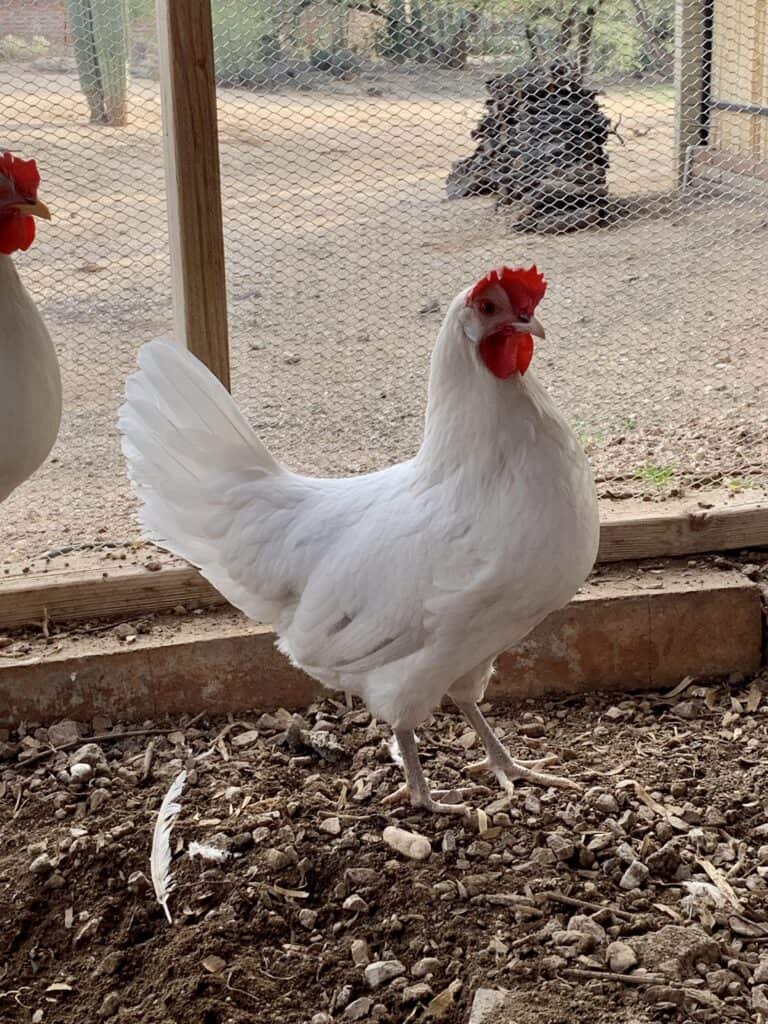
FAQs
What is a California white chicken?
A California White chicken is a hybrid chicken, resulting from the cross between a White Leghorn hen and a California Grey rooster (also a hybrid breed itself – Barred Plymouth Rock hen x White Leghorn rooster).
This unique blend gives rise to a bird well-regarded for its exceptional egg-laying capabilities, sturdiness, and adaptability, making it a favorite among poultry enthusiasts.
The California White, combining the best characteristics of its parent breeds, showcases a remarkable fusion of robustness and productivity in egg laying.
A California White chicken is a hybrid breed known for its prolific egg-laying capabilities and hardy constitution. Renowned for their egg production, they are a popular choice among poultry keepers, offering a blend of adaptability and low-maintenance care.
What color eggs do California White chickens lay?
California White chickens lay pure white eggs. Their egg production is impressive, providing around 300 large to jumbo-sized, pristine white eggs annually. These beautiful eggs not only appeal visually but also provide a robust source of nutrition.
Are California white chickens good to eat?
Yes, California White chickens are good to eat. While they are primarily raised for their egg production, these birds also provide quality meat.
Around the second or third year of life, when their egg production begins to decline, they can be an excellent source of lean, flavorful meat, adding a practical dual-purpose benefit to their keeping.
What age do California white chickens start laying?
California White chickens begin laying eggs around 17 weeks old. This early maturity, especially compared to non-hybrid chicken breeds, is one of the reasons they are so appreciated among chicken keepers.
By laying eggs at such a young age, they swiftly start contributing to the productivity of the backyard flock.
What is the temperament of a California White rooster?
The temperament of a California White rooster is typically calm and protective. They are less aggressive than many other rooster breeds, though they will defend their flock if they perceive a threat.
This makes them a good choice for those seeking a less aggressive rooster for their flock.
What is the difference between a rooster and a California White hen?
The primary difference between a rooster and a California White hen is gender, with the rooster being male and the hen female. This gender difference brings varying roles: Roosters are primarily for fertilization purposes. They can contribute to meat production but their primary role is not for meat.
On the other hand, California White hens are prolific layers, providing a steady supply of eggs while in their prime, and can also be utilized for meat as they age.
What is a California White chicken breed?
The California White chicken breed is a commercial hybrid, created by crossing a California Gray rooster with a White Leghorn hen.
This breed is well-regarded for its high egg productivity, often exceeding 300 large white eggs per year, and it also has a robust nature and adaptability to varying conditions.
What kind of rooster is all white?
The White Leghorn rooster is an example of an all-white rooster breed. This breed is well known for its bright, glossy white feathers.
Other breeds such as the White Plymouth Rock and the White Jersey Giant also have all-white roosters. Remember, while the California White rooster is predominantly white, it often has some light gray or black flecking in its plumage due to its California Gray ancestry.
When do California White chickens start to lay eggs?
These little powerhouses often start laying around the tender age of 17 weeks, outperforming other breeds in egg production.
California White Chicken
Raising California White chickens is great fun and pretty rewarding. These birds, with their white feathers and red combs really brighten up your backyard. Plus, they lay lots of large, white eggs.
They’re easy-going birds and do well in all kinds of places, whether you’ve got wide open spaces or a small city yard. They’re friendly and lively and get along with other chickens if you raise them in a mixed flock with easy-going breeds.
Keeping California White chickens is fun – and that’s what backyard chickens are all about.
So, if you want a bird that gives you loads of eggs and some good meat, the California White chicken could be a good fit for you. Especially when the hens get older and start laying less, you’ll appreciate having a good meat bird. They really do give you the best of both worlds in chicken keeping.
Keep learning about raising chickens:
Featured photo of California White chicken ~ Image credit: Dawn Head

